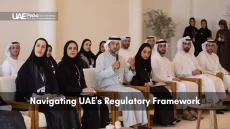What makes the United Arab Emirates work? It’s a mix of old and new ways of leading. The UAE is a federation of seven monarchies, each with its own ruler. This setup shows how the country balances unity and freedom for each emirate.
The president is usually from Abu Dhabi, and the prime minister from Dubai. This unique system is all about finding a balance. It’s a story of leadership and new ideas.
UAE Public Administration Leadership Structure and Hierarchy
The UAE has a complex leadership system. The Federal Supreme Council is at the top. His Highness Sheikh Mohamed bin Zayed Al Nahyan is the President, chosen on May 14, 2022.
The Cabinet has 37 ministers, with 9 women. His Highness Sheikh Mohammed Bin Rashid Al Maktoum leads as Prime Minister.
Federal Supreme Council and Executive Leadership
The Federal Supreme Council is the UAE’s top authority. It picks the President and Vice President. His Highness Sheikh Mansour bin Zayed Al Nahyan is the Vice President and Deputy Prime Minister.
Cabinet Composition and Ministerial Roles
The Cabinet makes federal policies and laws. It also watches over federal departments. Important roles include Health, Finance, and Interior.
It makes sure the UAE is well-run.
Integration of Local and Federal Administrative Bodies
Local governments in each emirate have their own power. This mix of federal and local leadership is special. It lets each area get the help it needs.
| Cabinet Composition | Number |
|---|---|
| Total Ministers | 37 |
| Women Ministers | 9 |
| Key Ministries | Health, Finance, Interior, Foreign Affairs, Tolerance, Sports, Energy, Infrastructure |
The UAE’s gender-balanced cabinet (24% female representation) exceeds global averages for women in ministerial positions Ref.: “UNDP (2022). Women’s Political Participation in the Arab States. United Nations Development Programme.”
Evolution of Government Leadership in the Emirates
The United Arab Emirates (UAE) has changed a lot since 1971. Its leadership has grown with the country. Oil found in Abu Dhabi in 1958 changed everything.
The first Cabinet was led by Sheikh Maktoum bin Rashid Al Maktoum. Later Cabinets saw changes in leadership. The UAE has grown, focusing on Emiratization and leadership styles.
The electoral college grew from under 7,000 to over 337,000 by 2019. This shows the UAE’s commitment to public sector management. Women make up half of the Federal National Council members now.
The UAE works hard on security and planning. The Supreme National Security Council was started in 2006. It includes important leaders for a strong national security.
The UAE cares about leadership development. It offers great education and training. Women are a big part of university graduates. The government helps with health insurance and housing.
The UAE’s government keeps getting better. It’s ready for the 21st century. The country leads in public sector management and leadership styles.
Future-Focused Leadership Development Programs
The UAE is working hard to create new leadership programs. These programs help the next generation of public leaders. Sheikh Mohammed bin Rashid Al Maktoum started the Future Government Leaders program. It aims to make skilled Arab leaders for the future.
Leadership Training and Capacity Building
This new program is the first in the Arab world. It has 40 leaders from 20 Arab countries. They learn about leadership, global trends, and digital transformation.
The UAE wants to grow a new group of leaders. These leaders will help the country grow and change.
Digital Transformation in Administrative Leadership
The UAE knows digital governance is key. It’s working to make its leaders good at digital things. This way, the UAE can lead in technology.
Women’s Leadership in UAE Government
The UAE is also helping women become leaders. 9 out of 37 cabinet ministers are women. This shows the UAE’s support for women in leadership.
The UAE wants a public sector that is ready for the future. It wants to be inclusive and meet the needs of its people.



















